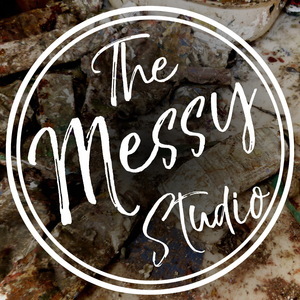Chilling In The Comfort Zone
Episode 78 · June 29th, 2019 · 27 mins 55 secs
About this Episode
Links
Intro
Notes;
"for everything there is a season"... no one right answer for all times for any one person. Just as in the rest of life, sometimes we need to set some boundaries and other times be open to changes and challenges.
Episodes 64 and 65 in March—all about change and its benefits.
Today: the legitimate reasons not to change/ some ideas about how creative boundaries can be beneficial.
Let’s start with the idea of self-imposed limitations—aspects of comfort zone that can be very helpful / strengthen our work. Focus, developing ideas, going deep. Such as:
limiting yourself to certain approaches in the studio:
materials, style, subject matter, scale etc
working in series
sticking with an idea until it is played out
(As opposed to limitations coming from outside ourselves such as limits on our studio time, finances, or physical limitations.)
We do need to question is they are simply default, fall-back answers? The downside of comfort zone—
When thinking of self-imposed limitations in a conscious way: ask yourself:
Are you just doing what’s easiest, most convenient
Just doing what you’ve always done
Its what sells
None of these inherently negative but worth looking at more closely—is it what you really want? Re-listen to the Change podcasts for advice if you feel bored or stuck/you know you are in a rut.
IF your boundaries seem reasonable and intentional to you, change for change’s sake is probably not going to be helpful. You also don't want to set aside valuable skills you've developed.
The term comfort zone—in the art world it’s generally used to designate something we should avoid. Has negative connotations. Not moving forward or being innovative.
However Wikipedia defines it as:
"a psychological state in which things feel familiar to a person and they are at ease and in control of their environment, experiencing low levels of anxiety and stress. In this zone, a steady level of performance is possible."
Looking at comfort zone without judgement, these are some characteristics:
You feel mastery with your media
You’re expressing your ideas without a lot of struggle
Good level of productivity
Work is of consistent quality
you may not make huge advances but you will maintain the quality of your work
organic change can happen more slowly
The key is how you are felling:
satisfaction, pleasure—positive comfort zone/often called the zone, things are flowing, you are in the groove, you are focused, without anxiety, at ease
OR “same old, same old” boredom, feeling locked into a box—negative comfort zone/you are stagnating, negative feelings
Positive comfort zone may be more beneficial once you are a fairly developed artist; don't settle for a comfort zone too early
Negative comfort zone –you cling to the idea that things are OK because change is scary—self-reflection—the need to be very honest with self
You can start to completely identify your own work only as one thing, one approach, media, material. You can pigeonhole yourself and others will too. Wouldn’t you rather have the self-image as someone who keeps growing and branching out over time?
Always stay sensitive to when something has run its course
Others may see this before you do because we can be blinded by our need for safety
Can be very hard to get out of this zone; observations as instructor; artists esp. successful ones can become very invested in a particular thing they do; but there may be an underlying dissatisfaction.
Another negative comfort zone is a little different—it’s not doing the same thing all the time but always doing different things. Never committing. This is comfortable because you can always just skim the surface. Always say, “just playing.” Has the illusion of being daring or taking on challenge but lacks depth of true exploration. Topic for another podcast.
IF you’re in a positive comfort zone change for change’s sake is not helpful. Resist well-meaning advice to “leave your comfort zone” just because it is considered a good thing.
Twyla Tharpe discusses this in terms of “ruts and grooves” in her book, The Creative Habit.
With a rut you are stuck, mired into something, lack of forward momentum.
With a groove you are moving forward in a smooth and productive way.
You have focus—going deep--
But also be conscious of where you may be limiting yourself in a negative way.
allow your boundaries to be a little porous. Once in while put them aside and venture somewhere else.
It can be fun and energizing to leave a positive comfort zone for a bit—try a different medium, new techniques. Cross-pollination.
Personal example of mine in current work: source ideas are shifting.
A comfort zone can be your mastery of the medium.
Psychologically healthy to avoid a lot of stress.
To wrap up—our comfort zones have very positive aspects—can keep us on track, deepen our work, provide focus and productivity. Just make sure they are conscious decisions rather than something you have fallen into and never questioned. And also allow your own boundaries to be a little porous. Once in while put them aside and venture somewhere else. A comfort zone should always be positive, not a box but a place that feels good, good energy, pleasure in your work.
